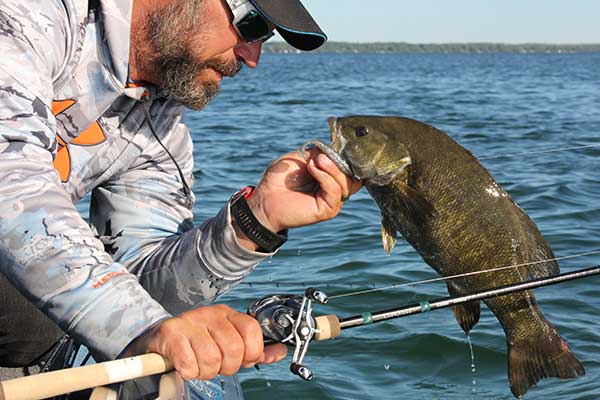By Louie Stout
 Timing is Everything on Quirky Simcoe Smallmouth
Timing is Everything on Quirky Simcoe Smallmouth
Newmarket, Ont. – JP DeRose peered over the nose of his 20-foot Bass Cat bass boat and pointed to a spot on the bottom in five feet of water.
We had been fishing for a couple of hours without a fish.
“There’s a big one next to that rock!” he said anxiously. “Throw your bait on the shiny spot next to the rock.”
I pitched the Ned Rig to the spot, lifted the rod tip and felt nothing.
DeRose looked at me like he’d seen a ghost.
“When are you going to set the hook?” he said sarcastically. “He’s got it.”
I never saw the fish or felt any movement. In fact, it was difficult to even see the rock with the gentle waves that churned above it.
I looked like a rookie.
By the time I snapped back on the 7-foot medium action Conquest Spinning rod, my line was four feet away from the rock. A 4-pound smallmouth rocketed to the surface, wallowed a bit, then raced off like it was shot from a canon.
Line buzzed off the spinning reel and I knew I had my hands full.
After several tense seconds passed, my partner netted the fish.
We were on Lake Simcoe, Ontario’s fourth largest inland lake located an hour or so north of Toronto. I was the guest of Bruce Holt, G. Loomis Rods executive, who was fishing with another local expert elsewhere on the lake. Holt wanted to give me hands-on experience with G. Loomis rods and Shimano Tackle’s new rods and reels. Shimano is the parent company of G. Loomis.
DeRose is host and producer of “Breaking Boundaries,” a fishing show on the WFN Cable Channel and Waypoint TV. He’s also a well-known smallmouth expert on Simcoe and a G.Loomis/Shimano Tackle pro staffer.
Lake Simcoe is 19 miles long and 16 miles at its widest point. It’s a very deep lake, except for miles of rocky shoals. Other than largemouth and smallmouth bass, it’s home to variety of species, including lake trout, walleye, whitefish, and muskies.
The trip was planned to coincide with the bass season opener, which kicked off two days prior to our trip, and what was expected to be prime smallmouth bedding season.
But, like most of northern U.S., a late spring has had Canadian seasons messed up. We fished two long and tough days; except for a few early spawners and wary cruisers, the bass weren’t ready to leave Simcoe’s deep haunts to start the mating season.
And believe me, we tried finding them. We visited dozens of DeRose’s big fish spawning haunts, but most were void of smallmouth.
We caught and released a few 3- to 5-pounders, but nothing like we expected.
But the potential for a giant smallmouth is there.
“You stand a better chance of catching a 7 pound smallmouth here than anywhere else in North America,” said a disappointed DeRose. “I cannot believe these fish simply haven’t moved up yet.”
That’s one of the issues of making a long trip during the spawning season. It’s all about weather and timing.
But then, Simcoe isn’t like most smallmouth fisheries. The bass there don’t act like they do in Michiana.
For example, in most northern U.S. lakes, the fall season delivers big, aggressive smallmouth feeding aggressively on shallows and rocky shoals before winter.
It doesn’t happen at Simcoe, said DeRose.
“Our best fall action occurs in late October or early November when the fish school and suspend in 30 feet of water,” he explained. “You don’t get that aggressive shallow feeding action in the fall like you do in most of the U.S.”
Much of the lake’s quirky nature is probably related to the forage. Exotic gobies found their way into the lake, likely from misplaced bait buckets, but the lake also includes big native populations of yellow perch, emerald shiners, crawfish, smelt and herring.
“We don’t have the numbers of smallmouth like a lot of northern lakes, but the fish we do have are big,” DeRose said. “You hear of the occasional 8 pounder but there are a lot of fish in the 4- to 7-pound range.”
Given the lake’s size, wind can make Simcoe mean. We were lucky – it never blew much over 10 mph while we were there. But there are several large, rock-lined offshore islands to tuck behind and get out of the wind and rough water.
“July is the best month for numbers of fish because the weather is more stable,” he said. “That’s also when we get a huge crawfish hatch in 12 feet or less and that draws the bass shallow.”
Because the shoals are so big and long, DeRose recommends anglers use lures that cover water quickly to find the fish. He uses baitfish-colored Jackall Rerange jerkbaits or Jackall or 3.8-inch Rhythm Wave swimbaits until he starts getting bites and then slows down to fish with tube baits, Crosstail Shads (drop-shot) or a Ned Rig TRD worm to catch the fish.
“If you’re looking for the biggest smallmouth of your life, it’s here,” insisted DeRose. “You get on the right spot and hook a big smallmouth, you may have 20 big ones following the hooked fish to the boat.”
We obviously missed that big fish action by a week, but that’s OK. Any day of fishing is better than a day at work.


